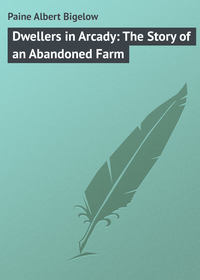 полная версия
полная версияA Little Garden Calendar for Boys and Girls
Davy held up what he had brought. The Chief Gardener took the stem of the Virginia creeper. Branching from it were five little stems with a small leaf on each. Prue had taken one of these to be a complete leaf, when it was really only a part of one compound leaf divided into five parts.
"You see, Prue, there is only one stem that joins the main stalk," explained the Chief Gardener. "Whatever branches out from that stem is a part of that leaf. What else have you brought, Davy?"
Davy held up a blackberry leaf, and the leaf of a tomato.
"Those are both right," said the Chief Gardener. "The blackberry has three parts like the bean, and the tomato has a good many parts. There are some leaves that are compounded as many as four times – each little stem being compounded over and over until there are hundreds of little parts, and yet all are connected with the main leaf-stem which joins the stalk or branch, making really only one leaf. Of course, it is not always easy to tell about leaves, any more than about flowers. Sometimes shapes are so peculiar that it is almost impossible to tell just what they are. Pine-needles are leaves, but it is hard to tell whether they are simple or compound, and it would be hard to tell whether the pine was an Exogen or an Endogen if we had only the needles to go by."
"But you haven't told us how to tell that by the leaves at all," said Davy. "That is what we started to find out."
"That's so, Davy. It's hard to keep to the subject in botany. There are so many things, and all so interesting."
The Chief Gardener took up the lily leaf and that of the blackberry, and held them up to the light.
"Do you see the difference?" he asked.
"Why, yes," said Prue, "the blackberry is all criss-crossy, and the lily leaf runs straight and smooth."
"Those are the veins," said Davy; "I heard Mamma say so."
"Yes, they are the veins," nodded the Chief Gardener, "and when they form a network, or run criss-crossy, as Prue says, it means that the plant is an Exogen. When they run side by side smoothly, as they do in corn and grass, it means that the plant is an Endogen. There are a few of both kinds which do not quite follow this rule, like the pine-tree, which is an Exogen, but has its little straight-grained needles, or like smilax, which has netted leaves, but is an Endogen."
II
SOMETIMES I THINK PLANTS CAN SEE AND HEAR
It was about a week after this that Davy and Prue came to the Chief Gardener with their hands filled with leaves.
"We want you to tell us about them," they said. "There is a lot of kinds and shapes, and some we can't tell whether they are simple or compound, or anything."
The Chief Gardener looked over their collection.
"Well," he said, "I am afraid you are getting ahead too fast. It would take a real sure-enough botanist to tell all about these leaves."
Davy picked up a daisy leaf.
"Is that simple or compound?" he asked.
"It's mostly ribs," laughed the Chief Gardener. "There really isn't much leaf about a daisy leaf, but what there is of it is simple, only it is so cut and sprangly that it might almost be called a compound leaf."
They looked at many others in the collection, and the Chief Gardener explained as far as he could.
"You will learn all the names of the different shapes some day," he said, "but it is too much for little folks. I suppose, though, you might remember the parts of a leaf. They are the blade, the stem, and the stipules."
"This is the blade, and this is the stem," said Davy, "but what are stipules?"
The Chief Gardener picked up a red clover leaf, and pointed to a little thin pale-green husk where the stem joined the main stalk.
"Those are stipules," he said. "In the clover they grow together, as one. The stipules are a part of the outside of the leaf-bud. When the bud opens, and the leaf goes out into the world, the stipules stay behind. Sometimes they are like little leaves, and take up air for the plant, just as the leaves do. Sometimes they almost take the place of leaves, and are quite large. Sometimes they are very tiny, and some plants have no stipules at all."
"But leaves have veins, too," said Davy.
"Those are parts of the blade. The blade has ribs – they make a framework which holds it together; also veins – the fine threads which help to carry the sap. You see, plants are a good deal like ourselves, and live much in the same way. Some leaves have only one strong rib through the center – a sort of a backbone. Some have as many as six or seven."
They talked about these things, and looked at the different leaves and stems. Then they spoke of the stalks of different plants, and the Chief Gardener explained how the tender stalk of the lowliest plant, that of the tall twining vine, and the trunk of the giant oak, were all one and the same, only different in kind. Each came at some time from a tiny seed. Each put forth buds and leaves and branches. Each was made to withstand the storm – the oak by its strength, the vine by its fast hold on the wall or lattice, the tender plant through its lowliness.
"Oh," said Davy suddenly, "that makes me think of something. Our Virginia creeper on the front lattice has three ways to climb."
"What are they, Davy?"
"Why, it twists, for one way."
"Twines, you mean."
"Yes, twines, and then it has little curlers, like a grape-vine."
"Tendrils, they are called, Davy."
"And little clingers, like an ivy."
"Feet, you should say. Yes, I have noticed that. A lattice is not very well suited to a Virginia creeper, and ours has to try every way known to vines, to hold on. I have never known all three ways on one vine before. But vines are very curious things. Sometimes I think they can see and hear. I know they can feel, for a honeysuckle shoot will grow perfectly straight until it touches something that can be climbed. Then it will begin to twist so fast you can almost see it."
"But why do you think they can see and hear?" asked little Prue.
"I don't know that I do really think so, but I have tried every way I can think of to keep those morning-glories of yours from running up my little pear-tree. I have pushed them away, and tied them away, and I have even cut some of them away. But if I turn my back for a day, or even a half a day, there is one of them starting up the stalk, or, at least, reaching out for it as hard as ever it can."
Little Prue laughed, and ran over to see. Yes, there it was – a fuzzy green shoot half-way up the little pear-tree, and three more reaching out in the same direction.
"A vine will grow in the direction of a tree or shrub, if it is half way across the garden from it. Whether it hears or sees, or, perhaps, smells it, I do not know. Some vines will turn out of their way for a drink."
"For a drink! Oh, Papa!"
"Yes, certain melon vines. In dry weather they will turn to find a pan of water set several feet away. I suppose they can sense the moisture from it."
The children talked the rest of the afternoon about these curious things. They found where a scarlet runner had traveled several feet through the grass to reach a peach-tree, and had climbed far up into its branches. Then Davy happened to remember the story about the vines which the Chief Gardener had told them during the winter, and told it all over to little Prue – how the honeysuckle had laughed at the scarlet runner and the morning-glory, and had been punished by being made to twine to the left, away from the sun, instead of to the right, toward it, like the morning-glory and the bean. So the happy summer day passed, and in the cool of the evening big Prue came out to watch the sun go down, and in the pleasant arbor they all had tea together.
III
THERE ARE PLANTS WHICH DO NOT BLOOM
But during the last two weeks of August the Chief Gardener and big Prue and little Prue and Davy all went to the seashore, which was not far away. They lived in a pretty cottage near the beach, and there were meadows behind that stretched away to the blue hills. Davy and Prue loved the sea, with all its curious shells and star-fishes and other wonderful creatures. They loved the white sand, where they found these things, and where the great waves billowed and broke over them when they bathed on hot afternoons. They loved the meadows, too, for here there were birds building in the grass, and flowers unlike any in their gardens, and little streams of clear water that went singing to the sea.
It was when they came from the meadow one afternoon, that they hurried to the Chief Gardener with the little basket which they always carried.
"We have found some things," said Davy, "and want you to look at them."
The Chief Gardener took the basket. On top were some mushrooms – two kinds. One had whity-brown tops, and was pink or brown or almost black underneath, while the other had yellow tops with white spots on them, and was very pale underneath. The Chief Gardener looked sharply at the children when he saw these yellow mushrooms.
"Go and wash your hands, quickly," he said, "and I hope neither of you have put your hands to your mouth since you touched these."
"I haven't," said Davy, "and I picked the yellow ones."
"They are deadly poison," said the Chief Gardener, "they are called the Amanita, and even to touch the tongue with your fingers after handling them might make you very ill. The others are meadow mushrooms and harmless. But even they could not be eaten after being in the basket with the Amanitas."
The children ran to wash their hands, and were presently back to ask questions. Meantime the Chief Gardener had found a lot of beautiful moss and ferns in the bottom of the basket, and some lichens, which the children had gathered from a rocky cliff not far away.
"Papa, aren't mushrooms toad-stools, and don't they build them to sit on, in pleasant weather, and to get under, when it rains?"
This was little Prue, and she was quite excited.
"I think they are some kind of plants," said Davy, "but I don't see where the flowers are, or how they make seeds."
"How about the ferns?" asked the Chief Gardener. "Did you find any flowers on the ferns?"
"No, but we found seeds."
Davy turned one of the fern leaves over, and, sure enough, there were a lot of little brown seeds under the ends of some of the leaflets. Then the Chief Gardener turned over one of the meadow mushrooms, and divided the little layers beneath with the tip of his pencil.
"That is where the mushroom keeps its seeds, too," he said. "We do not call them seeds, though, but spores. Fern seeds are called spores, also."
"But toads do sit under mushrooms, don't they?" insisted little Prue.
"Why, yes, I suppose a great many toads have done that, but they are really plants, as Davy says."
Davy had become thoughtful.
"Are they Exogens?" he asked, "or Endogens? I should think the mushrooms might be Endogens from their stems, and the fern Exogens from their leaves."
"Well, Davy, that is very well said, but they are really neither one. They belong to a great class of their own. Exogens and Endogens are only the two kinds of flowering plants. These mushrooms and ferns and mosses and lichens all belong to the flowerless plants, and are called Crip-tog-a-mous – a very long word, which I do not expect you to remember. The divisions of flowerless plants are too hard a study for little folks, but the plants are all very interesting, and we can gather them, and see how they grow. In fact, I think we will have to call our meadow and our beach your August garden."
"But there isn't anything on the beach," said Prue.
"How about all that seaweed you were gathering yesterday?"
"But does that really grow like our plants on the shore?" asked Davy.
"Very much the same, and it belongs to the flowerless class, too, along with the mosses and lichens and ferns and mushrooms. It has spores instead of seeds, and is really a sort of a moss of the sea."
"Oh, call us not weeds, we are flowers of the sea,For lovely and bright and fresh-tinted are we,"sang little Prue, with a memory of her kindergarten.
"Yes, they are flowers of the sea, though they do not bloom," said the Chief Gardener, "and are very beautiful in color and form. I will give you some white cards and you can gather specimens to dry. You spread out the little branches with a tooth-pick, and the cards make pretty little books afterwards."
"But do seaweeds and mosses and lichens and ferns and mushrooms all belong to one family?" asked Davy.
"Oh, by no means. Not even all to the same division of flowerless plants. But it is too hard a study for a little boy, and it is enough to learn now that they do all belong to the big flowerless or Crip-tog-a-mous class."
"Papa, is it true that if you put fern seeds in your shoes, nobody can see you?" asked little Prue.
"Why, I don't very well see how 'nobody' could see you, but I think somebody might."
"It says in my fairy book that the princess put fern seed in her shoe, and then there wasn't any one who could see her. I wish it was like that. I'm going to try it," and the little girl pulled off some of the brown spores and tucked them in her dusty ties.
"Can you see me? Can you see me, now?" she asked, dancing about.
"Why, no," said the Chief Gardener, who pretended to be looking for her in another direction.
"Can you, Davy? Can you see me?"
"Not very well, when you go so fast," laughed Davy. "Stand still, and let me try."
Just then big Prue came out on the porch, and little Prue danced up to her.
"Can you see me? Can you see me, Mamma? You mustn't, you know, because I've got fern seed in my shoe."
Big Prue shut her eyes, and put out her arms.
"No, I can't see you," she said, "but you feel like the same little girl," and she kissed the little round tanned face on her shoulder.
IV
THE PRINCESS BY THE SEA
"I Heard you talking about flowerless plants," big Prue went on, "as I sat there by the window. I wonder if you would like to hear a little story of how they came to be without flowers."
"Please, yes!" and little Prue forgot her fern seed and hugged closer.
"Well, once upon a time there was a princess with a beautiful garden – "
"Is this the same princess that turned into a red rose?"
"Oh, no, this is another princess. There have been a great many princesses with gardens. This princess lived by the sea, where there was a meadow, and a cliff not far away, much like it is here. She loved her flowers more than anything in the world, and her garden was so beautiful that even the fairies loved it better than their own gardens of fairyland and came at midnight to dance in the moonlight, after the princess was asleep.
"And the princess knew that they danced there, for once a gentle fairy had come to her and told her of it, and warned her never to try to see them, for whoever sees the fairies dance by the midnight moon may meet with some dreadful misfortune, which even the fairies themselves cannot help.
"But when the princess heard about the fairy dance, she wanted to see it very much. Instead of trying to forget it and going to bed before it began, she thought of it all the time, and the more she thought, the more she made up her mind to see it, no matter what might happen afterwards.
"So one night, just before twelve o'clock, she crept into a large cluster of blooming ferns – "
"But ferns do not bloom – "
"They did then, and their sweet odor filled the still night air; the moon was white and round in the sky, and the level sea had a path of glory that led close to where she lay.
"The princess thought how beautiful was all the world, and especially her garden, and she grew sad to think that perhaps some time she would not be there to see it all. And then all at once she forgot everything else, for there in the moonlight were the fairies, dancing in a great glittering ring.
"The princess looked, hardly daring to breathe. Then it seemed to her that she could not see so well. She rubbed her eyes, but the world about her only grew dimmer still. She thought the moon had gone under a cloud, but it was sailing high in the sky. And then everything faded out, the world became dark and the princess gave a great cry of grief, for she knew that her punishment had come, and she was blind!
"The fairies heard the cry, too, and vanished, but the gentle little fairy who was her friend came and guided her in sorrow to her palace, and said, 'I can grant you one wish, but it must not be to see again – that I cannot grant.'
"'Then,' said the princess, 'if I cannot see my flowers, I wish that they may never bloom again until some one, who cares more for them than I, shall wish to see them.'
"And the wish came true. Never a flower in the garden of the princess bloomed from that day. Their buds dropped, their leaves shrank, and many of them hid away where they would not be seen by passers-by. Some slipped away into the water and became seaweeds. Some hid in the deep woods, and crept into dark places, and became ferns. Others, growing smaller each year, became moss. Some hid among the rocks of the cliff and became lichens. And some, who wanted to be useful if they could not bloom, scattered themselves over the woods and fields and became mushrooms. But some of these were of bitter or sharp nature, and these we cannot eat. And some grew wicked and vicious, and these are poison. One of them, the Amanita, which had bloomed as a great golden white-spotted flower in the garden of the princess, became the most vicious of all. It kept much of its color, which now makes people shun it because it is a sign of deadly poison."
"And will the flowers that grew in the garden of the princess never bloom again?"
"Never, unless some one who cares more for them than she did shall wish to see them."
"But how can I care so much unless I can see them?" asked little Prue.
"Perhaps that is why they will never bloom again," said Davy.
SEPTEMBER
I
A FLOWER REALLY HAS CLOTHES
THE little gardens were in quite a bad way when Davy and Prue came back from the seashore. Everything had done well, even to the weeds, and that was just the trouble. It took two whole days, working when the sun was not so very hot, to get the beds in shape, and the Chief Gardener had to work, too, very hard. But by and by everything was clean and beautiful again, and the seat under the peach-tree was a finer place than ever, because there were more things in bloom, and everything had become more beautiful.
One day Davy came to the seat, where little Prue and the Chief Gardener were resting, with a double carnation in his hand.
"I wish you would look at this," he said. "I can't tell petals from stamens."
The Chief Gardener took the flower, and slowly pulled it to pieces.
"Well, no," he said; "it isn't the easiest thing to do, though, of course, those anther-looking things must belong to stamens."
"But the filaments are like petals," objected Davy.
"Yes, and here are others like them, though they have no anthers. Those are supposed to be stamens, too, or, at least, they were stamens, once."
Davy looked puzzled.
"You remember I told you once, Davy, that a flower was only one form of a leaf – a leaf intended to make the plant beautiful, and to make it bear seed. Well, in some plants, especially cultivated ones, the flower-leaves seem to get rather mixed in their parts."
The Chief Gardener picked a scarlet canna that grew near.
"Here is a flower which has three little petals and four large flower-leaves which you would think were petals, wouldn't you? But the stamens and petals and sepals are so mixed that even botanists can hardly decide which is which. In a water-lily, too, the petals gradually become stamens, so, perhaps, the leaf came first, ages and ages ago, and little by little it has changed, first to sepals, then petals, then to stamens and pistils, so that it could make seeds and scatter them to the wind. Gardeners make double flowers out of single ones by a process of turning stamens and even pistils into petals. The double flower is sometimes very beautiful, but it is not the most perfect flower. The wild rose is more perfect than the finest double American Beauty. Perhaps double flowers came before single ones, a long time ago, when the leaves were turning to blossoms, so that the gardeners who make the wonderful double blooms now are really going backward instead of forward. But that is all too hard. I'm afraid – especially for a little girl who likes very double carnations."
"I know everything you're talking about, just as well as Davy does," said the little girl, sitting up quite straight. "And I like single flowers, 'specially lilies, and wild roses; but I think double flowers are nice, too, because they seem dressed up, like folks – queens and princesses, all with nice dresses – velvet and chiffon and lacey stuff."
"Why, that is just what they are, Prue. They are dressed up, and, of course, the more anything, or anybody, is dressed up the less they are really like themselves. The petals and sepals of a flower are really fine clothes, you know, just as you sometimes play they are, when you make hollyhock dolls, and it wears them for just about the same reason that we wear ours. It might grow and be useful without them, but it would not be very attractive, and some of its friends and servants might pass by without seeing it."
"Servants! But flowers don't really have servants. That must be just a story."
"No – at least, it is all very true. Flowers are like people in very many ways. They really have servants and friends, and some of them live off other flowers and plants, and some of them eat and sleep, very much as we do. I will tell you something about that another time."
II
THE FLOWER HAS MANY SERVANTS
It was about a week after this that little Prue was picking some sweet-pease for the table when Davy came along with the Chief Gardener.
"The servants are busy this morning," said the Chief Gardener.
"Do you mean me?" asked little Prue. "I am trying to pick some flowers, but there are so many bees around that I'm afraid."
"Those are the servants I mean. I do not think they will hurt you if you are careful. They are only collecting their wages, and working at the same time."
Davy and Prue looked close.
"What do you mean by their working?" asked Davy. "Do you mean for the flower, or for themselves?"
"For both. Watch this bee. You see, he pushes open the flower for honey, but to get it he has to cover his legs with the pollen from the anthers, which are placed down in this little lower part called a keel, just where his legs and body will be covered. Then he comes out and goes to another flower and carries this pollen, and really rubs it on the stigma there as he crawls in and out, and takes more pollen, and so goes on from one to another – a real servant, doing a real duty and getting his pay as he goes."
"But he doesn't have to do it. The pollen would fall on the stigma anyway, wouldn't it?"
"It might with the sweet-pea, but even if it did, the pollen from the same flower is not as good as the pollen from another flower from a different plant, and the seed would be poor and the plants would grow weaker every year. There are many insects that act as servants to the flowers, and the wind is one of the servants, too. It shakes the corn-tassel so that the pollen falls on the silk and makes the ear, and it carries the pollen of one stalk to the silk of another – sometimes from one field to another."
"But, of course, the bee doesn't know that he does it," said Prue, who was still very intently watching the little servants of the sweet-pease.
"I am not so certain of that," the Chief Gardener said musingly. "The flower must know, for it dresses in bright colors so that the bee may see it, and offers honey as pay for his work. And if the flower knows, why shouldn't the bee?"
"But don't you think it might all just happen so?" asked Davy.
"I don't think anything in nature just 'happens so,' Davy, and I am sure that the bee's work for the flower doesn't, for there are too many flowers that would have no seed and would die out if it were not for the bees that carry the pollen, and most of these flowers have grown just to fit in every way the especial little bee, or big bee, or insect, that comes to work for them. There are some flowers, like the sweet-pea, that the bee cannot get into without getting pollen on his legs, and there are others that drop it upon his back. Some flowers have stamens that wither before the pistil is ready for the pollen. In such flowers the little servants go from one to the other – from a new flower to an old one – carrying the pollen which would not be of any use in the flower where it grew."











